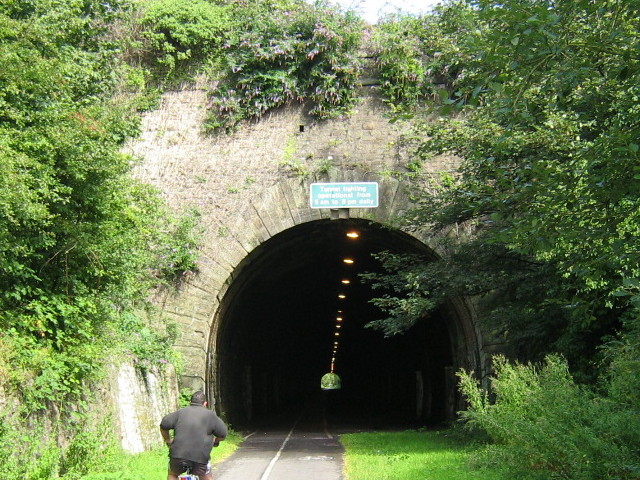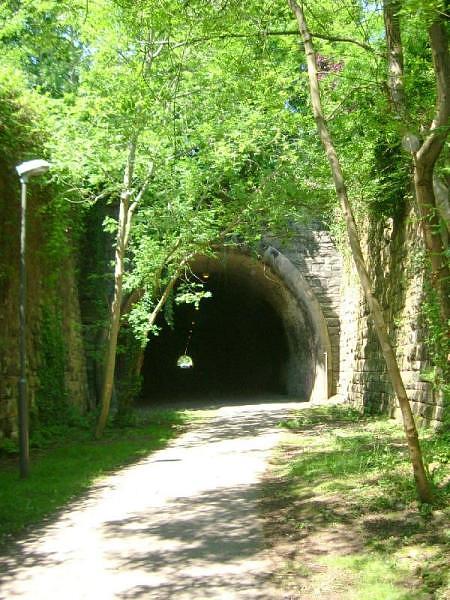

The Ledbury Area Cycle Forum believes that the time has come to consider the feasibility of reopening the disused Colwall Tunnel as a recreational and utility facility for cyclists and walkers. It is fully recognised that this would present a major task, requiring comprehensive political will and a successful funding application, but believes that a positive conclusion would provide considerable benefit to communities on both sides of the Malvern Hills. It is recommended, therefore, that a feasibility study be set up to assess support for the project and to ascertain the viability of the project in terms of engineering, safety, conservation and funding.
The 1567-yard (0.9 mile) long Colwall tunnel was opened in 1860, and closed in 1926 on the opening of the current parallel tunnel. The site is owned by Railtrack, but part managed by English Nature to protect a hibernating colony of Lesser Horseshoe bats.
Currently the tunnel lining is thought to be in poor condition, and this, together with the engineering of access routes, plus measures to protect the bat colony will present a serious funding challenge.
The tunnel has the potential to provide a valuable cycling and walking route for recreation and commuting between Colwall (and Ledbury) and Malvern, as well as offering opportunities to link the proposed Wye Valley Cycleway with the National Cycle route via Worcester. It is considered that the project would fully meet the objectives of the Malvern Hills AONB Sustainable Tourism Strategy.
The original 1567-yard Colwall tunnel was designed in the late 1850s and formed part of the Worcester and Hereford Railway. This line was built by a partnership including the Midland Railway and LNWR to link Birmingham with the coalfields and industry of South Wales.
However, the bore proved to be too narrow with the brick lining often being displaced by passing trains. Further problems associated with geological faults lead to a rock fall which closed the route for a week in 1907. The tunnel was finally closed in 1926 on the opening of the current wider tunnel.
During the Second World War a concrete floor was constructed and the lining repaired to allow the tunnel to be used as a store and distribution centre for Admiralty bombs. The main role for the tunnel today is to provide a hibernation site for over 100 Lesser Horseshoe bats - the largest colony in Herefordshire or Worcestershire.
The original Colwall Tunnel was engineered by Stephen Ballard of Colwall and the bore was completed in the summer of 1860. It is brick lined, with pumps to remove water from the many springs emerging from geological faults intercepted by the tunnel.
The Malvern Hills consist largely of syenite, a Precambrian granite-like rock formed some 700 million years ago. This rock is one of the hardest in the world and presented the tunnelling engineers with enormous difficulties and painfully slow progress. At the tunnel entrances the rock is kinder, with limestone shales at the Colwall portal, and red marl at West Malvern.
At the last count, some 120 Lesser Horseshoe bats were found to hibernate in the tunnel over the winter months. They enjoy the relatively warm temperatures, and tend to colonise the alcoves on the side of the tunnel. In order to support the colony, through draughts in the tunnel have been reduced by introducing baffles at the two mouths, together with a roof shoring structure which has reduced the height to 4 foot in one place.
The full colony hibernates from November through to late April/early May. During this period there may be a small amount of activity. It is also possible that some bats will seek shelter in the tunnel outside of the hibernation period.
Any works on this site will almost certainly require licensing through the DETR to comply with the EU Habitats Directive.
Any plan to reopen the tunnel must take full account of the need to maintain and enhance the current bat colony.
The tunnel could provide a valuable means of travel by cycle or on foot between Colwall and Malvern. Equally, as Colwall and Ledbury are joined by a pleasant country lane route, so the opening of the tunnel would provide a viable non-motorised link between Ledbury and Malvern for cyclists, avoiding the climb over the Wyche Cutting. We would anticipate that the link would be used for cycle commuting to Malvern as well as for recreational use.
A further important benefit would stem from the unusual nature of the facility and the considerable green tourism opportunities which would arise from it. The Malvern Hills area already attracts large numbers of walkers and cyclists but the tunnel would provide a further reason to visit the area. Such a facility could form a focus for a series of local walks and trails which could be advertised nationally as part of the thrust to enhance the local economy by promoting sustainable tourism.
In addition, the tunnel would be a valuable candidate for inclusion in the National Cycle Network which is planned to provide a loop from Worcester and Upton via Malvern. The tunnel would further provide the opportunity for a link to Hereford and the Wye Valley Cycleway and hence to South Wales. This presents real possibilities for developing local sustainable cycle-related tourism opportunities.
Implementing a project of this nature will have the added local benefit of drawing together communities and institutions on either side of the geographical barrier.

The success of a project of this size will depend on building successful partnerships with local communities and interested organisations. This will include:
A programme will need to be developed in consultation with these partners to:
The prospect of reopening the tunnel was briefly investigated by Hereford and Worcester Countryside Service in the mid-1990s, but was shelved as it was judged to be a project with no easy solutions.
Since then, Government interest in encouraging sustainable transport policies has led the Ledbury Area Cycle Forum to reconsider the project and to include it in the Ledbury Area Cycling Strategy.
As part of Ledbury Area Cycle Forum's submission to Herefordshire Council on the Local Transport Plan, it was recommended that funding for a feasibility study should be included in the LTP-F3 Capital Expenditure bid for 2001-2002. It was also recommended that notional funds for implementation of the tunnel project should be included in the LTP bid for future years.
Colin Palmer
June 2000
For Ledbury Area Cycle Forum
Tel: 01531 633500 email: [email protected]
The idea of renovating disused rail tunnels for walkers and cyclists is nothing new.
The two photos on this page show the tunnels Kingswood, South Gloucestershire and at Ashbourne, Derybshire.
The new Two Tunnels Greenway project
aims to develop a new shared-use path for the city of Bath, UK, and its neighbouring settlements of Midford, Wellow and Radstock/Midsomer Norton, making use of two disused rail tunnels.
Over in the USA, things are done (as ever) on a bigger scale.
The paper TUNNELS ON TRAILS: A Study of 78 Tunnels on 36 Trails in the United States
gives case studies for tunnels up to 2.3 miles long.
The biggest concern most people will have is safety and lighting of the tunnel if used as a public cycle and footpath. All the safety features listed below would increase cost, but they would all be cheaper if designed-in rather than retrofitted.
Assuming the tunnel is one mile long and the average person can walk at 3mph, it would take 20 minutes to walk through. Lighting should be on permanently with battery backup for considerably longer than 20 minutes if the mains fails. There are several ways of doing this:
In addition, cyclists should be required to use lights.
This is a problem in all tunnels. Suggest an inner skin that would collect any water and direct it to drains either side. This skin should be pale in colour to reflect available light as much as possible. Tunnels can be intimidating, and a light colour gives reassurance.
A risk that must be considered seriously. All wiring must be concealed, preferably behind the inner skin recommended earlier. CCTV cameras linked to Malvern police station would be advisable.
It might be necessary to close it before the pubs shut and re-open it at dawn.
CCTV would help with this. Fire risks would be very low, but the possibility of arson must be taken into account. Fire alarm type panic buttons placed at intervals and linked to the police station should be considered.
If the tunnel was wide enough to take a train, it could take a car. This would be advantageous to allow emergency and maintenance vehicles in, but there must be tight control to ensure that unauthorised motor vehicles cannot get in. This is necessary both from the safety and ventilation points of view.
Therefore, users must accept access controls that will bar motorbikes effectively, and the best type is the one featured in Sustrans information sheet FF22, examples of which are on the Whitehaven to Ennerdale path. This consists of a low hoop that a bike pedal can clear when up, with a gap just wide enough to clear the rest of the bike including the 'down' pedal. There is a 'U' bend alternative for wheelchairs and pushchairs.
The 'bike' part permits solos and tandems to pass but unfortunately not trailers, which would have to be unhitched and taken through the 'wheelchair' part. It can catch panniers, but it will defeat motorbikes because their footrests would get caught. It might also bar recumbents.
The 'wheelchair' part will defeat a motorcycle steering lock, but might also bar an electric wheelchair. A way out of this would be to have a RADAR access as well.
All the above would require development which was sensitive to the needs of the bat colony.